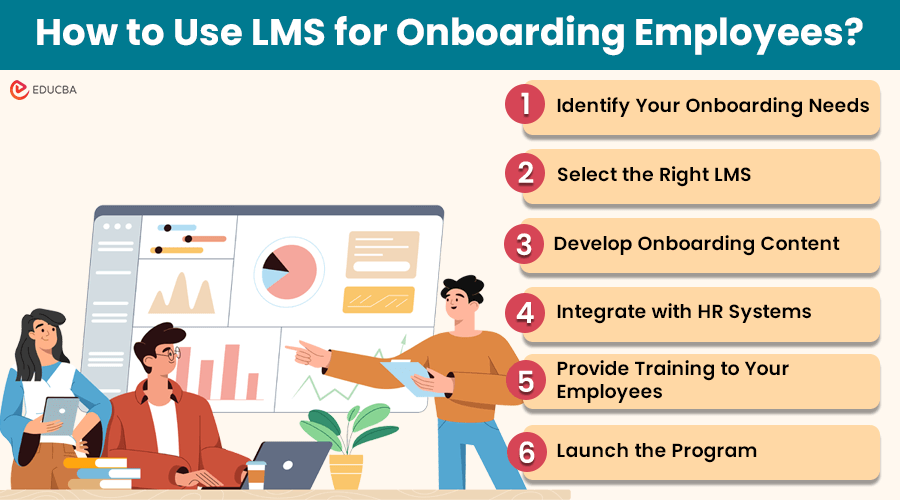
What is LMS for Onboarding?
LMS for onboarding means using a learning management system to manage, track, and deliver training materials for new employees in an organization.
Effective onboarding helps new employees understand their roles, setting them up for long-term success. Employees may face low productivity, burnout, and feeling out of place without proper onboarding. Traditional onboarding can take months, which is especially tough in industries like hospitality, banking, and HORECA (Hotel, Restaurant, and Café/Catering). Using an LMS for onboarding prepares new hires to excel in your organization.
For example, international banks can implement LMS to develop training programs for bank employees and boost onboarding. There are several hospitality LMS systems that can help the hospitality industry simplify the process. Many organizations have already implemented this practice and have seen great results. AcademyOcean reports that its customers have reduced onboarding time by half, leading to significant cost savings.
How to Plan Your LMS Onboarding Strategy?
Having an LMS is not enough; you need a clear strategy to maximize its benefits. Planning ensures clarity and alignment with company goals.
1. Set Clear Objectives
Define specific, measurable goals for your LMS onboarding program. These objectives should align with your company’s needs and overall goals.
2. Identify Stakeholder Roles
Determine the key participants in the onboarding process, such as HR, department managers, IT, and subject matter experts. Clearly outline their roles, responsibilities, and levels of involvement.
3. Determine Content
Break down content creation into stages. Start with general topics useful for the entire team. Conduct a thorough analysis to identify specific training needs based on job roles, compliance requirements, company culture, and unique organizational needs.
How to Implement LMS for Onboarding?
Here’s a step-by-step guide to help you implement an LMS for onboarding:
1. Identify Your Onboarding Needs
Before selecting an LMS, assess your onboarding process. Identify the key areas where new employees need training and determine the goals of your onboarding program.
2. Select the Right LMS
According to Meticulous Research, the LMS market is vast and is projected to reach $28.1 billion by 2025. It means that there are numerous LMS systems for you to choose from. To choose an LMS that fits your company’s needs, list important features and rate them by importance from 1 to 10. Then, schedule demos to find the best platform for your organization.
3. Develop Onboarding Content
Once you have chosen an LMS, focus on creating engaging onboarding content. Share company policies, procedures, and videos that highlight your organizational culture. Enhance these materials with interactive elements, simulations, and gamified modules. Include assessments and knowledge checks to ensure comprehension.
4. Integrate with HR Systems
Ensure your LMS integrates seamlessly with existing HR systems. This synchronization allows for smooth updates of user profiles, job roles, and other critical details, eliminating the need for manual data entry.
5. Provide Training to Your Employees
Equip your employees with the skills to use the LMS effectively. They should learn to use the platform’s tools to create engaging and immersive learning experiences. Establish guidelines for content maintenance to keep onboarding materials current and relevant.
6. Launch the Program
Prepare user guides, tutorials, and support resources to help new hires navigate the LMS. Make these guides the first course for new employees, enabling them to learn the platform before diving into job-specific training.
7. Gather Feedback and Work on it
Use analytics and feedback to refine your onboarding program. Assess course completion rates, engagement metrics, and test results to identify areas for improvement. Gather input from stakeholders, managers, and trainers to ensure the program’s effectiveness. Keep content updated to make sure it’s accurate and interesting.
Key Features to Look Before Choosing the LMS for Onboarding
1. User-friendly Interface
A user-friendly and simple interface is essential for any employee onboarding LMS. Both administrators and new employees benefit from an intuitive and visually appealing design that allows seamless navigation and interaction.
2. Customization Options
Opt for a platform with a wide range of customization options, especially those that offer flexible, white-label solutions. This ensures brand consistency throughout the onboarding process.
3. Content Management
The LMS should support various content formats, including text, images, videos, presentations, quizzes, and interactive modules. It should also offer easy content creation and management tools for administrators.
4. Compliance and Security
Ensure that the LMS complies with industry regulations and data security and user privacy standards. Look for role-based access control, data encryption, and compliance reporting features.
5. Integrations
Strong integration capabilities are crucial for streamlining processes and ensuring data consistency. To enhance efficiency, select an LMS that can seamlessly integrate with your existing system.
Final Thoughts
Utilizing an LMS for onboarding provides a structured, efficient, and engaging way to introduce new hires to their roles and the company culture. Carefully creating onboarding content aligned with specific goals enhances employee engagement, accelerates time to productivity, and builds the foundation for long-term success.
Recommended Articles
We hope you found this article on LMS for onboarding in an organization informative. For more HR-related content, read the following articles.

